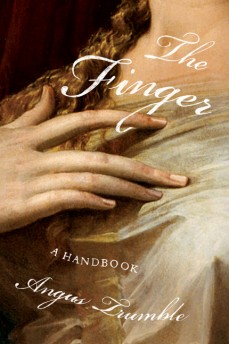 Reviewed:
Reviewed:
The Finger by Angus Trumble
Farrar, Straus and Giroux, 290 pp., $28.00
The book publishing industry has lately been carving up the human body with the gusto of an organ-transplant surgeon after a freeway pile-up. In recent years, we’ve seen books devoted to the history of the heart, the breast
, the butt
, the penis
, and the vagina
, not to mention blood
, urine
, and shit
. Hair most of all has gotten the fine-tooth comb; we now possess individual volumes on red hair
, 19th-century hair
, and African-American hair
.
This reflects a larger trend toward “microhistories.” An author picks out a narrow, seemingly unpromising topic—salt, concrete, the color blue—and attempts to make interesting its peregrinations through history. This may be a symptom of the diminishing ambition of our historians, but the genre deserves to be taken on its own terms. The microhistory surprises and delights when it connects distant eras and refracts major events through an unusual lens. It grates when it resorts to sheer gimmickry and dispenses with context.
The micro-anatomy books also reflect our obsession with bodies: their gratification, mortification, and modification. We eat, exercise, and nip and tuck in record quantities. Professors write on and teach courses on “the body” in departments of anthropology, sociology, literature, history, art history, women’s studies, black studies, philosophy, and religion. (Americans are not the only obsessed. The French recently produced a three-volume history of the body.) Need I refresh your memory of the recent theater hits “The Vagina Monologues” and “Puppetry of the Penis”?
For chroniclers of the body, there remains distressingly little corpus incognita. So, for his latest book, art historian Angus Trumble, who had previously written a history of the smile, had to settle for the finger. Penis historian David M. Friedman got to use chapter titles like “The Demon Rod,” “The Gear Shift,” “The Measuring Stick,” “The Cigar,” “The Battering Ram,” and “The Punctureproof Balloon.” Trumble can do little better than “The Finger and the Economy” and “The Strange Status of the Thumb.”
Trumble’s book opens with a supremely unpromising topic—How should we number our fingers?—but he makes it fly. We learn, for instance, that the “ring finger” originated in antiquity, which held that a vein connected this finger directly to the heart. If any other author told me he had gotten the idea for his book while giving “a talk at a conference about hand injuries,” I’d close the book. When Trumble did, it renewed my faith in serendipity. I’d read him on Reverse Polish notation.
Trumble’s full title is The Finger: A Handbook. Some might call his fondness for wordplay a weakness, but it allows him to deftly demonstrate the finger’s ubiquity in our language. He notes that figures of speech involving the finger are usually negative (“all thumbs”), and he explains why:
. . . among the ingredients of the witches’ cauldron in Macbeth, perhaps the most revolting is “Finger of birth-strangled babe, ditch-deliver’d by a drab.” No doubt this vulnerability to pejorative usage is at least partly due to the persistent idea, originating with Aristotle, that the sense of touch is comparatively “dark,” or at least lower in rank than sight, hearing, smell, and taste—in that order. To Aristotle the sense of touch was the most basic of all the senses, indeed the only one common to all animals.
Trumble is at his best when talking about hands in art, unsurprising given that he is by day senior curator at the Yale Center for British Art. His insights freshen up everything from Picasso’s Guernica and Rembrandt’s Anatomy to cave painting (often made by men with missing fingers, he reasons). Here he is describing Michelangelo’s God reaching to Adam on the Sistine Chapel ceiling:
The junction of these two magnificent hands, the one brimming with energy, the other with incipient life, is endlessly reproduced as a detail—these days in advertisements for electrical goods or financial services. We tend to see it as magical, animating, supremely eloquent. But there is good evidence to suggest that the gesture with which God the Father summons Adam into being is not magical so much as military . . . Supported by angels, God commands man into corporeal existence: “Be!”
Ever fewer careers require the skilled use of our hands. Professional athletes number more than they did a century ago, but you cannot mass them against the vanished woodcarvers, blacksmiths, and couturiers. Ours is the age of the desk job, and for today’s typists and clickers, manual dexterity is helpful but rarely essential. So hands are becoming increasingly invisible to us. Today we glimpse but little of their expressive power and beauty. This forgetting infuses Trumble’s microhistory with urgency. Salt and concrete, after all, aren’t going anywhere. Trumble’s achievement is to reacquaint us with a part of ourselves we take for granted, to re-enchant it, to lift up something ordinary and render it newly strange and beautiful.
Jon Lackman has written for Slate and Harper’s. He is completing his PhD dissertation on invective in 19th-century French art criticism and is the editor of ArtHistoryNewsletter.com.
Mentioned in this review:

